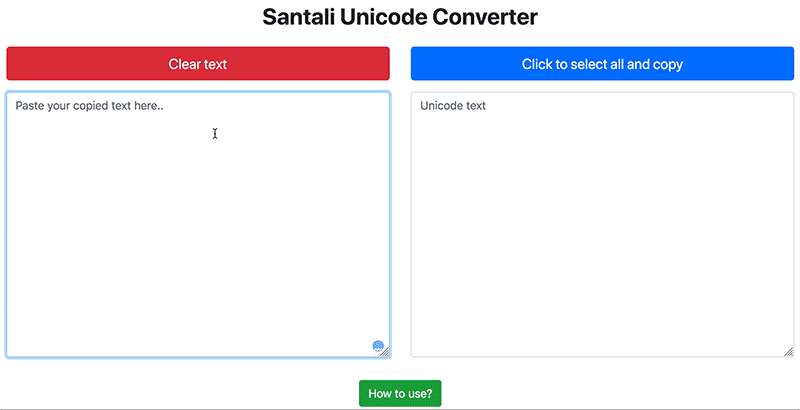
UNESCO considers Media and Information Literacy (MIL) as “an important prerequisite for fostering equitable access to information and knowledge and promoting free, independent and pluralistic media and information systems“. MIL is broadly based on the “information and media in our everyday lives“ and this page lists links to such resources in the Santali (ᱥᱟᱱᱛᱟᱲᱤ), and its writing system Ol Chiki (ᱚᱞ ᱪᱤᱠᱤ). Such resources are intended to be used by both Ho users and others alike. Generally, input tools, mobile apps, character encoding converters, Wikipedia and other Wikimedia projects, typefaces/fonts are the common resources included in such a directory.
Last updated: December 2, 2020
Background
Santali is one of the indigenous languages that is spoken by roughly about 7.6 million people (including 6.9 million native speakers in India. Census 2011) that live mostly the eastern/northeastern states of India (Assam, Bihar, Chhattisgarh, Jharkhand, Mizoram, Odisha, Tripura and West Bengal). The Santali diaspora also lives outside India in Nepal, Bangladesh and Bhutan. The formal and the most widely writing system for Santali is Ol chiki/Ol cemet’ (Unicode range: 1C50–1C7F; see progress of recent changes) whereas Devanagari, Bengali and Odia have/are been used. Ol chiki is a non-abugida writing system that was developed by Pandit Raghunath Murmu in 1925. Santali is one of the very few Adivasi (indigenous) languages that is a part of the Eighth Schedule of the Indian Constitution (see provincial distribution). Despite of inclusion of the language in the elementary education system in a few Indian states (Jharkhand, Odisha and West Bengal), the written and online use of the language have a long way to go. Many native Santali speakers are constantly striving to put their language on the world map of late.
This page went live around the time when the Santali Wikipedia finally went live at https://sat.wikipedia.org in August 2018. Members of O Foundation in their volunteer contributor capacity as well as in professional roles were also involved in the development of input tools, typefaces, and organizing outreach to grow the contributor community for creating and maintaining content, tools and other digital resources in Santali.
Technical resources
Input tools
Input tools used to type in the Ol chiki writing system using a computer or a mobile device.
- Android: Some of the popular ones include GBoard by Google, Indic Keyboard Swalekh Flip, Multiling O Keyboard + emoji) (also see: Santali notepad, 1, 2, 3, 4, 5, 6, 7, 8, 9, 10)
- Desktop: Guru Gomke, cross-operating system input tool to type in Ol chiki that was developed during 2014-2015 by Jnanaranjan Sahu, Nasim Ali and Subhashish Panigrahi (project page) at the Centre for Internet Society’s Access to Knowledge program
Ol chiki typefaces
- Openly-licensed Unicode fonts:
- Guru Gomke (designed by Pooja Saxena, commissioned by Centre for Internet Society’s Access to Knowledge program)
- Google Noto Ol Chiki
- Legacy fonts (not Unicode):
Other technical resources
- Ol chiki converter, a web-based encoding converter to convert text typed in some of the most used legacy encoding systems into Unicode (read in English)
- Ol Chiki Tech, a blog posting updates on technological development for Santali
Content
- Santali Wikipedia, an open online encyclopedia in Santali where anyone can contribute reliable information
- “Sarala (tribhasi) Bhasha Sikshyana Pustika“, trilingual (Santali-Odia-English) dictionary by Special Development Council, Mayurbhanj, Planning & Convergence Department, Government of Odisha, India [Open Access, CC-BY 4.0]
- Online news portals
- Creative literature:
- Khobor Kagoj, online version of the Santali newspaper with same name
- We Santhals, a portal for Santali language, people and culture
- Educational:
- Syllabus for UGC NET Santali, Dec 2013 (in Devanagari)
Other linguistic resources
- ISO 639-2 code “SAT”, ISO standard naming for Santali on Library of Congress
- ScriptSource (script description)
- Ethnologue listing
- Spoken L1 Language: Santali, Glottolog listing
- Omniglot listing
- OLAC resources in and about the Santali language
- Romanization Tables at Library of Congress (see full list)
- The Language ArchiveZide, Norman. “Three Munda Scripts“. Linguistics of the Tibeto-Burman Area. Volume 22.2 – Fall 1999. University of Chicago.
- Recording of biblical verses. Global Recordings Network
- Santali Localization. Andovar
Inputs from Ramjit Tudu and Anwesh Pati.






Could any one of you plz guide me in downloading one/two books in Ol Chiki script (must be Unicode-compliant, not scanned copy) to help me out in experimenting text analysis possibilities with Santali language document available in Ol Chiki script?
There have no any complete unicode-compliant books in Ol chiki script, but you can get some ocr scanned books.